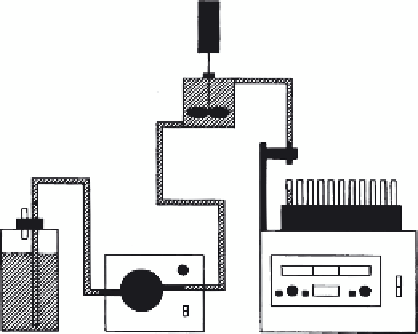Agriculture Reference
In-Depth Information
Stirred-Flow Reactor Method
Stirrer
Reactor
Fraction
collector
Pump
Reservoir
FIGURE 2.19
A stirred-flow reactor connected to a reservoir of a solute through a pump. The effluent is
collected by a fraction collector. (From H. M. Selim and Amacher, M. C. 1997.
Reactivity and
Transport of Heavy Metals in Soils
. Boca Raton, FL: CRC Press. With permission.)
soil chemists and biogeochemists. The stirred-flow method is best regarded
as a modification of the batch reactor method where reactions take place dur-
ing continuous flow or transport. Selim and Amacher (1997) provided a his-
torical perspective and modifications of the stirred-flow method as well as
mass balance calculations for quantifying the amount sorbed versus time.
The stirred-flow method is a combination of mixing and transport methods
and is applicable for quantifying solute adsorption as well as desorption and
release. Inherent advantages and disadvantage of the stirred-flow method
are analogous to those of the mixing and transport methods. Sparks (2003)
provided critical evaluation of this method, and of the various parameters
that may be controlled (e.g., pH, Eh, etc.) during the experiment.
2.3.6 Miscible Displacement
Miscible displacement methods were originally developed by chemists and
chemical engineers and are convenient to measure the transport of reactive
chemicals in soils or porous media. The methods account for physical pro-
cesses that govern solute transport in soils, including mass flow or convec-
tion, diffusion, and longitudinal dispersion. A primary use of these methods
is not only to quantify rates of solute adsorption or desorption but also to
quantify the physical characteristics governing solute transport in porous
media. This is often achieved by use of a tracer or nonreactive ions such

Search WWH ::

Custom Search